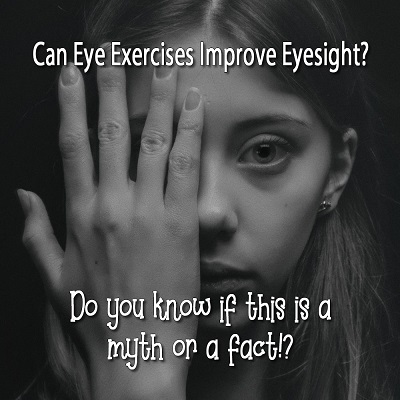 The self-help industry is big! Now more than ever folks are learning all about homesteading and sustainable living, what things to eat to ward off illness and disease, repurposing techniques, and all sorts of ways to improve ones’ life with the DIY method. It’s not far fetched then consider the idea of improving eyesight with exercises.
The self-help industry is big! Now more than ever folks are learning all about homesteading and sustainable living, what things to eat to ward off illness and disease, repurposing techniques, and all sorts of ways to improve ones’ life with the DIY method. It’s not far fetched then consider the idea of improving eyesight with exercises.
Except that it’s completely unfounded, and it goes against the basic anatomy and structure of the eyeball. Sure, the self-help programs advocating this type of nonsense are boasting all sorts of numbers, statistics and even empty promises that you will be able to toss your glasses out the window when you’re finished following their techniques.
Since the 1920s these programs have popped up from time to time and should be no real shocker. We’ve got knifes that can cut through the hood of a car, a towel that can hold a gallon of water, juicers, mixers, and a plethora of other fancy gadgets flooding the late-night channels just waiting for a gullible buyer to fall for their antics hook, line and sinker.
Let’s take a deeper look at why these claims of improved eyesight with eye exercises aren’t going to cut the mustard.
A Lesson in Anatomy
First, we’ve got to understand the basic anatomy of the eye and it’s surrounding structure. Your eye is a complex organ that has a hefty job – eyesight. These are the main parts of the eyeball itself:
- Iris – the colored part of the eye
- Sclera – the white part of the eye
- Conjunctiva – thin layer of tissue that covers the sclera
- Cornea – clear front surface that covers the iris; similar to the lens of a camera.
- Pupil – opening in the center of the iris that allows light in
- Lens – sits just behind the iris and pupil
- Retina – light-sensing cells on the back wall inside the eyeball used for peripheral vision
- Macula – light-sensing area inside the retina used for central vision
- Optic Nerve – receives data from the retina to take to the brain to determine what is being seen.
Imagine looking at a painting. The reflected light from all the many colors and shapes in front of you passes through the cornea and enters the eyeball through the pupil. It then hits the lens and then ends its journey at the retina and macula. This is where the magic happens.
The retina sends electrical impulses, by way of the optic nerve, to the brain. The brain returns the favor by telling us what the image is. Notice, not once in that description is a “muscle” used.
What Causes the Need for Corrected Vision?
Other than trauma, infection or congenital anomaly, we can give credit of failing eyesight to the natural aging process. If our body ages, it must also be true that our eyes do the same.
When you have blurry vision and need corrective eyewear, it’s caused by a reflective error. A reflective error occurs, in most cases, by the shape of the eyeball itself, or the shape of the cornea.
In someone with nearsightedness, their eyeballs are shorter than they need to be. Likewise, in someone with farsightedness, their eyeballs are longer than they need to be for 20/20 vision.
An astigmatism is due to a misshapen cornea. For all of these situations, the light coming in through the pupil isn’t reaching the retina properly; a reflective error.
Again, not once is a muscle mentioned.
How Can You Improve Eyesight?
If exercises aren’t the answer, what is? The obvious answer is corrected vision with glasses, contacts or surgery. Oddly enough though, diet and nutrition also play a big role in eye health. Certain vitamins and minerals have been linked to better resistance from age related eye diseases. Careful management of other health issues and routine comprehensive eye examinations are also key.
The whole point is the eyeball isn’t a muscle. You simply can’t exercise your eyeball. You can, however, exercise the muscles around your eyeball. They control eye movement; blinking, winking, squinting and up/down/left/right movements of the eyeball.
Of course, you can play tricks on your vision or “train” your eyes to have quicker responses for focusing, but your actual vision isn’t going to be affected in the least bit. Not scientifically anyway. No study has proven otherwise, despite the claims of self-directed eye exercise programs.
If you want to improve your eyesight, the best idea is to seek the advice of your eye care professionals and get your peepers examined.






